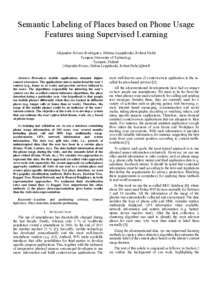Semantic Labeling of Places based on Phone Usage Features using Supervised Learning
Rivero Rodriguez, Alejandro; Leppäkoski, Helena; Piché, Robert (2015-02-05)
Rivero Rodriguez, Alejandro
Leppäkoski, Helena
Piché, Robert
IEEE
05.02.2015
Julkaisun pysyvä osoite on
https://urn.fi/URN:NBN:fi:tty-201603013584
https://urn.fi/URN:NBN:fi:tty-201603013584
Kuvaus
Peer reviewed
Tiivistelmä
Nowadays mobile applications demand higher context awareness. The applications aim to understand the user's context (e.g., home or at work) and provide services tailored to the users. The algorithms responsible for inferring the user's context are the so-called context inference algorithms, the place detection being a particular case. Our hypothesis is that people use mobile phones differently when they are located in different places (e.g. longer calls at home than at work). Therefore, the usage of the mobile phones could be an indicator of the users' current context. The objective of the work is to develop a system that can estimate the user's place label (home, work, etc.), based on phone usage. As training and validation set, we use a database containing phone usage information of 200 users over several months including phone call and SMS logs, multimedia usage, accelerometer, GPS, network information and system information. The data was split into visits, i.e., periods of uninterrupted time that the user has been in a certain place (Home, Work, Leisure, etc.). The data include information about the phone usage during the visits, and the semantic label of the place visited (Home, Work, etc.). We consider two approaches to represent this data: the first approach (so-called visits approach) saves each visit separately; the second approach (so-called places approach) combines all visits of one user to a certain place and creates place-specific information. For place detection, we used five popular classification methods, Naïve Bayes, Decision Tree, Bagged Tree, Neural Network and K-Nearest Neighbors, in both representation approaches. We evaluated their classification rates and found that: 1) Bagged Tree outperforms the other methods; 2) the places data-representation gives better results than the visits data-representation.
Kokoelmat
- TUNICRIS-julkaisut [16951]
